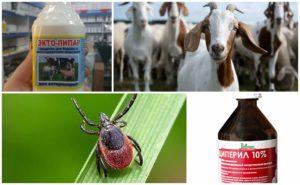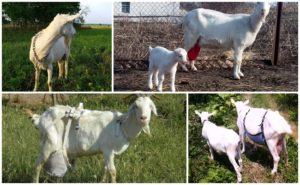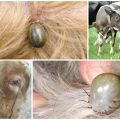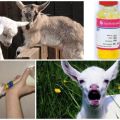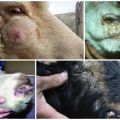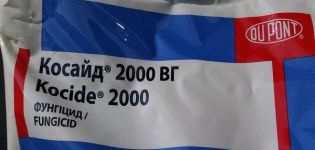Causes and symptoms of piroplasmosis in goats, treatment and prevention
Tick-borne diseases are diagnosed in goats during the warm season and in certain regions. The cause of diseases is not the ticks themselves, but the microorganisms that live in their body and, when bitten, enter the body of the ruminants. Consider the causes and symptoms of piroplasmosis in goats, the diagnosis of the disease and its therapy, what needs to be done to prevent the onset of the disease in pets.
Causes of the disease
The causative agents of piroplasmosis are the protozoa Piroplasma ovis. The disease is seasonal and appears during the mite breeding season (May-August). It is registered in the southern regions. Goats suffer from pyroplasmosis often in combination with babesiosis, which is caused by a similar type of parasite - Babesia ovis. Protozoa are carried by Rhipicephalus bursa ticks. The disease is typical for goats, sheep, cows, horses. Animals of all breeds are sick, from a year old. Young animals rarely get sick.
Protozoa parasitize in the erythrocytes of animals, they get there after a tick bite. In ticks, they are found in saliva.
Disease symptoms
Piroplasmosis is acute and subacute, rarely chronic. After infection of animals in the pasture, the incubation period of piroplasmosis lasts 1-2 weeks. The first signs of a disease that has already begun to develop are an increase in temperature to 42.4 ° C, depression, and a decrease in physical activity. Animals move little, lie more in shady places, react poorly to what is happening. Their breathing and pulse become more frequent, muscle tremors are observed. Milk yield in milking individuals decreases. The mucous membranes turn red at first, but after a couple of days they become pale yellow.
The work of the scar at first slows down, stops for 4-5 days. The feces are dry, but covered with mucus, sometimes blood is visible on it. The urine is initially yellow and cloudy, then it may turn red. In previously ill individuals, with repeated infection, the disease can turn into a chronic stage. With exacerbations, their temperature rises, edema, cachexia, and depression are noted.
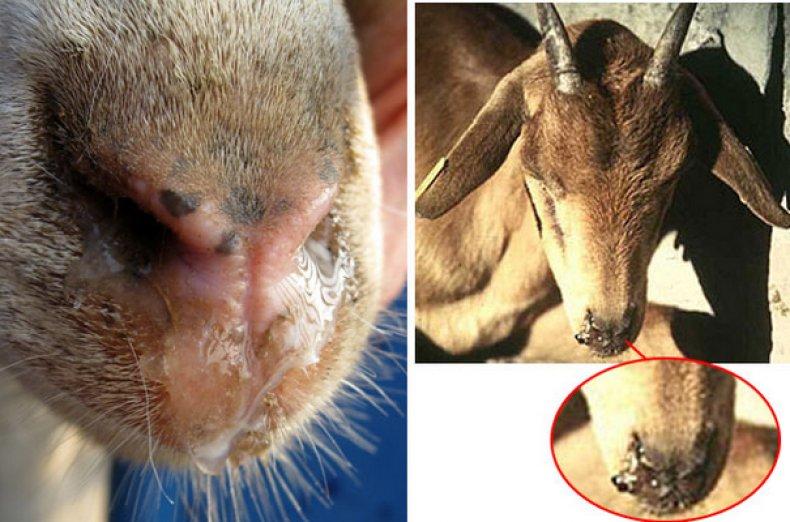
Diagnostics
Diagnosis is based on blood tests. In samples, pyroplasma are found only after the appearance of signs of the disease in sick individuals - temperature.
When making a diagnosis, take into account the season and region where the ticks can live. Piroplasmosis is differentiated from leptospirosis, anthrax, anaplasmosis due to similar symptoms.
Pathological changes in piroplasmosis in dead animals - emaciation, pallor and yellowness of the mucous membranes. Enlarged spleen and kidneys with punctate hemorrhages under the capsule. The heart is pale, also enlarged, hemorrhages in the epicardium or myocardium. The liver is also enlarged, jaundiced, clay-colored, tissues are easily torn. The intestinal walls are thickened and also covered with hemorrhages. Outpourings of blood are found on the serous membranes of organs.
Treatment of piroplasmosis in goats
After identifying sick individuals, all goats need to measure the temperature. Those who have it increased are injected intramuscularly with a 7% solution of "Azidin" or "Berenil". The dosage is 0.0035 g / kg. "Azidine" can be replaced with a 1% solution of "Hemosporidin". The drug is administered subcutaneously in a volume of 0.5 mg / kg.
The next day, the temperature is measured again. Animals with readings above 40 ° C are injected again. Individuals with normal temperature are observed for 3-4 days, if during this time there are no changes, they are released to the rest of the goats.
Patients for the period of treatment are separated from healthy ones and placed in a separate goat's house. The room should be cool. Diet - grass and roots, fresh water. Additionally, vitamin B12 is injected or injected into food, since a deficiency of this substance is formed during pyroplasmosis.
Additional drugs to maintain the systems and organs of sick animals - caffeine to stimulate cardiac activity (orally or subcutaneously), to stimulate the work and cleanse the intestines - laxatives and enemas. The dosage of all medications and the treatment regimen should be selected by a veterinarian, you cannot treat yourself.

Undesirable consequences
Without treatment, piroplasmosis is a fatal disease. Its duration is 5-10 days. The death of goats can be 60-80%. But even with therapeutic support, recovery is slow. Self-healing does not occur. Traditional methods of treatment are ineffective. Recovered animals acquire non-sterile immunity, which lasts for a year. There is no long-term immunity, that is, theoretically, goats can become infected with piroplasmosis every season.
Preventive actions
If goats graze on pastures where there have been cases of piroplasmosis, the animals are bathed in acaricidal baths or treated with sprays. If there are many ticks on the site, such treatments are carried out every week and a half.
When keeping goats on pastures in summer, try to overtake goats there in spring, before ticks appear in the imago stage. When new animals are purchased, they are quarantined, examined and given Azidin. Preventive measures in the form of treating goats with acaricides are the main method of combating the disease. It is better to periodically bathe or manually process animal skins than to treat them for a long time.
Goats get sick with pyroplasmosis from late spring to autumn, in those places where the presence of ticks is noted. These are small parasites, which are difficult to notice on the body of an animal. They not only feed on the blood of ruminants, but can also bring them more evil - infecting a deadly disease. If it is not possible to graze goats on pastures clean from parasites, you need to examine them more often and treat them with acaricidal preparations for prevention.
